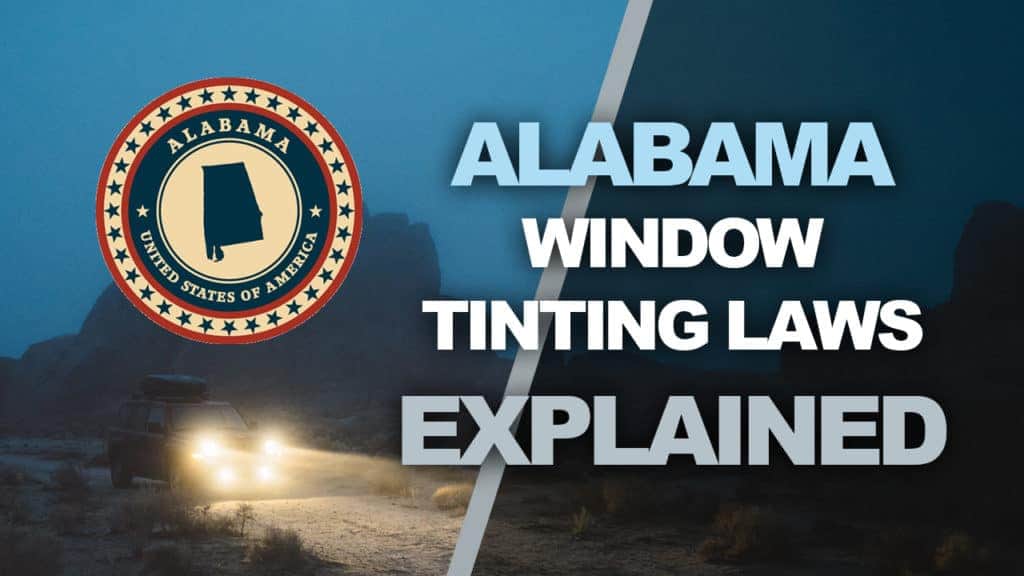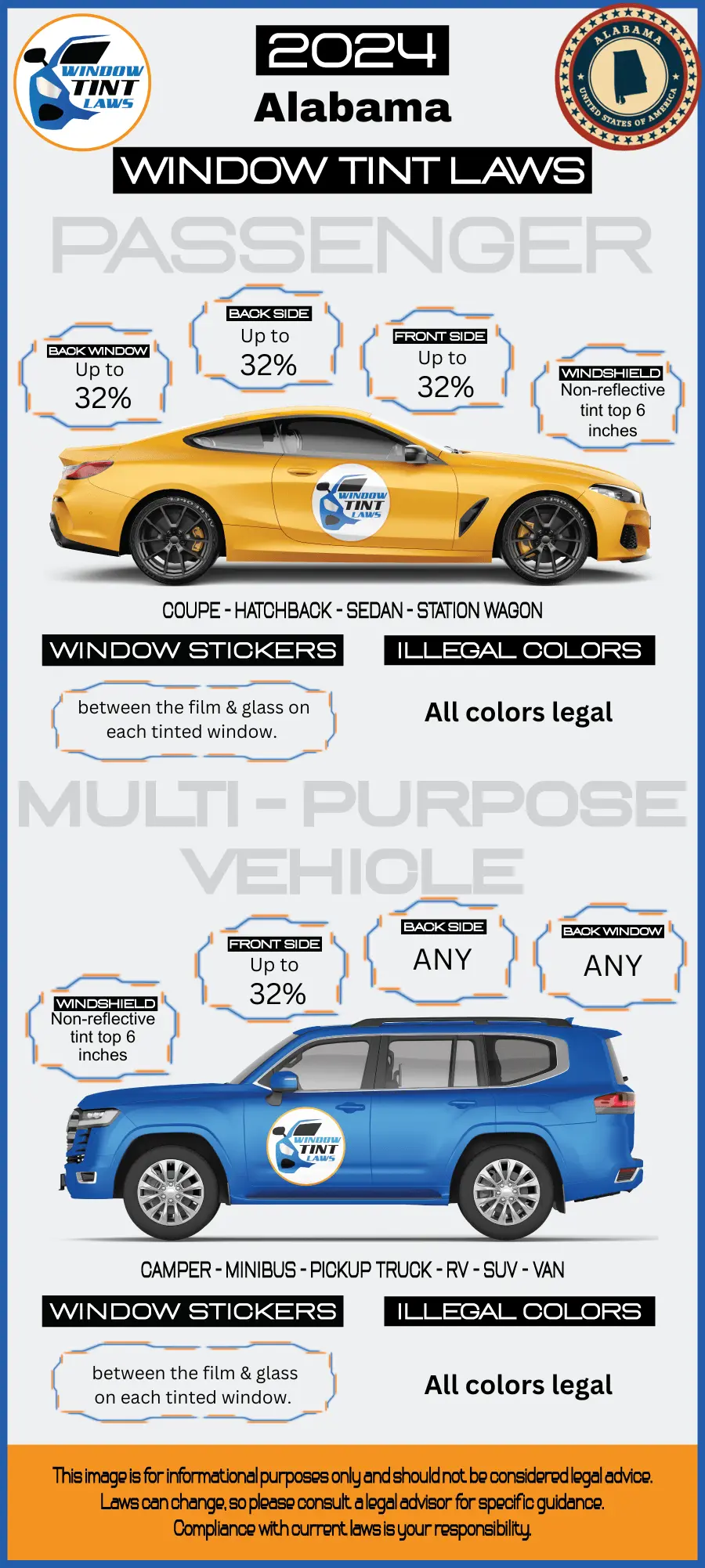

Article Created by Ryan Pietrzak
Last updated on February 14, 2024Alabama Tint Laws – 2024 Updated Legal Tint Limit
Please note that Alabama Tint Laws Regulation can change daily and may be interpreted differently at the city or county level. We recommend verifying this information with your local DMV or law enforcement agencies. We have manually fact-checked this content using official state resources. Alabama enacted tinting laws in 1996. If any information provided is incorrect or outdated, please contact us so we can make the necessary corrections. Thank you.
2024 Alabama Tint Laws – Legal Tint Limit For Passenger Vehicles
- Front Windshield: Non-reflective tint is allowed on the top 6 inches of the windshield. Windshield – Non-reflective tint is allowed above the manufacturer’s AS-1 line. No tint is permitted below the AS-1 line.
- Front seat side windows: up to 32% tint darkness allowed. Front Side Windows – Must allow more than 32% of light in. This means the tint cannot block more than 68% of light.
- Back seat side windows: up to 32% tint darkness allowed.
- Rear window: up to 32% tint darkness allowed. Tint cannot block more than 68% of light.
2024 Alabama Tint Laws – Legal Tint Limit For Multi-Purpose Vehicles
- Front Windshield: Non-Reflective tint is allowed on the top 6 inches of the windshield
- Front seat side windows: up to 32% tint darkness allowed
- Back seat side windows: Any tint darkness can be used
- Rear window: Any tint darkness can be used

- Medical exemptions: Alabama tint laws permit darker tints on front side windows with a doctor’s note
- Alabama tint laws prohibit metallic or reflective tint on any of the windows
- Alabama tint laws are statewide with no additional local regulations
- Violating Alabama tint laws can carry a maximum $100 and/or 10 days in prison for first conviction. Second conviction within a year max $200 and/or 30 days in jail. Third and subsequent offense within a year $500 and/or up to 3 months in prison.
What does VLT Mean according to Alabama Tint Laws?
- Window tint film’s light transmission is measured as VLT (Visible Light Transmission) and each state has its own legal limits for VLT on car windows.
- A HIGHER VLT means that more light is allowed to pass through the window tint film.
- Example: a 75% tint will allow 75% of the light to pass through whereas a 5% tint will only allow 5% of the light to pass through, making the 5% tint a much darker film.
- Alabama window tint laws has specific VLT limits for Passenger Vehicles and Multi-Purpose Vehicles.
FAQ’s Regarding Alabama Tint Laws and Alabama Legal Tint Limit
What is the darkest legal tint in Alabama?
In Alabama, the darkest legal tint for front side windows is usually 32% VLT (Visible Light Transmission), which means that at least 32% of light must pass through the window. However, tint laws can vary by vehicle type and other factors as in medical exemptions, so it’s essential to check the specific regulations in your area.
Are police exempt from window tint laws in Alabama?
In Alabama, police vehicles are typically exempt from window tint laws, allowing them to have tinted windows that may be darker than what is legally allowed for civilian vehicles.
How do I get a tint waiver in Alabama?
To get a tint waiver in Alabama, you typically need to have a medical condition that requires special window tinting for UV or glare protection. You would need to obtain a medical certificate from a licensed physician, and then you can apply for a tint waiver through the Alabama Law Enforcement Agency (ALEA) by providing the necessary documentation. Specific requirements may vary, so it’s advisable to check with ALEA for the most up-to-date information.
How much is a tint ticket in Alabama?
Typically, fines for window tint violations could range from around $100 to $250 or more. However it’s essential to check the latest information with your local law enforcement or the Alabama Law Enforcement Agency (ALEA) for the most accurate and up-to-date information on window tint fines in Alabama.
Can you get pulled over for tint in Alabama?
Yes, you can get pulled over for window tint violations in Alabama. Law enforcement officers in Alabama have the authority to stop and ticket vehicles with window tint that does not comply with the state’s regulations. If your vehicle’s window tint is too dark or does not meet the legal requirements, you may be subject to a traffic stop and potentially receive a citation. It’s important to ensure that your vehicle’s window tint complies with Alabama’s laws to avoid any issues with law enforcement.
How to get a Tint Exemption in Alabama
Alabama State Law allows window tint medical exemptions to be given to vehicle owners or passengers who regularly drive with the vehicle owner. To file for a medical exemption in Alabama you will need a written statement from a licensed physician in Alabama. If you have been diagnosed with Light-Sensitive Porphyria you can file for an exemption. If you are granted a medical exemption for whatever reason it is important to understand that you must display your medical exemption decal on the windshield. This Decal will have your unique identification number that the law enforcement officers will use to verify the authenticity of your exemption. You will have to pay a fee upon acceptance of your medical exemption in order for a decal to be issued
For more information regarding window tint medical exemptions in Alabama you can check out these resources:
- Alabama Window Tint Medical Exemption Law – Alabama State Website
- Alabama Law Enforcement Agency – medical exemption contacts
How do you file for a window tint medical exemption in Alabama?
In order to file for a window tint medical exemption in Alabama, you will need to contact the Alabama Law Enforcement Agency’s Driver License Division, Medical Records Unit. They can be reached by mail at P.O. Box 1471 Montgomery, AL 36102 or by Phone @ 334-242-4239

Ryan Pietrzak
Creator of Windowtintlaws.us

